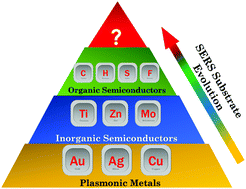Surface-enhanced Raman spectroscopy (SERS): an adventure from plasmonic metals to organic semiconductors as SERS platforms
Abstract
The quantitative determination and identification of bio-/chemical molecules at ultra-low concentrations is a hot topic in several fields including medical diagnostics, environmental science, and homeland security. Molecular detection techniques are conventionally based on optical, electrochemical, electronic, or gravimetric methodologies. Among these methods, surface-enhanced Raman spectroscopy (SERS) is considered as one of the most reliable, sensitive and selective techniques for non-destructive molecular analysis through the amplification of electromagnetic fields and/or creation of charge-transfer states between the chemisorbed analyte molecule and SERS active platform. Unfortunately, the applicability of SERS is rather limited, which is mainly due to the lack of highly sensitive SERS platforms with good stability and reproducibility. In line with this, metal nanoparticles (e.g., Au, Ag, and Cu) have been extensively exploited as SERS active platforms. Although the utilization of metallic nanoparticles in SERS is simple and cost-effective, the poor controllability of the structures and limited formation of hot spots in the detection zone leads to discrepancy in the resulting SERS signals. For these reasons, in the past few years, researchers have focused on fabricating 3-dimensional (3D) SERS platforms, which increase the adsorption of analyte molecules and facilitate hot spot formation in all three dimensions. However, the fabrication of 3D SERS platforms is mostly expensive and technologically demanding. Therefore, the discovery of non-metal alternative approaches is of great interest not only to widen SERS applications but to further elucidate fundamental questions. Considering recent developments on the fabrication and application of SERS active platforms, this review is structured in 3 main directions; (1) implementation of the plasmonic nanoparticles having different shapes into SERS-active platforms, (2) highlighting recent developments in the fabrication and application of 3D SERS-active platforms, and (3) examination of recent novel inorganic and organic semiconductor based platforms for SERS applications. At the end, we conclude with the promises and challenges for the future evolution of SERS.

- This article is part of the themed collection: Recent Review Articles


 Please wait while we load your content...
Please wait while we load your content...